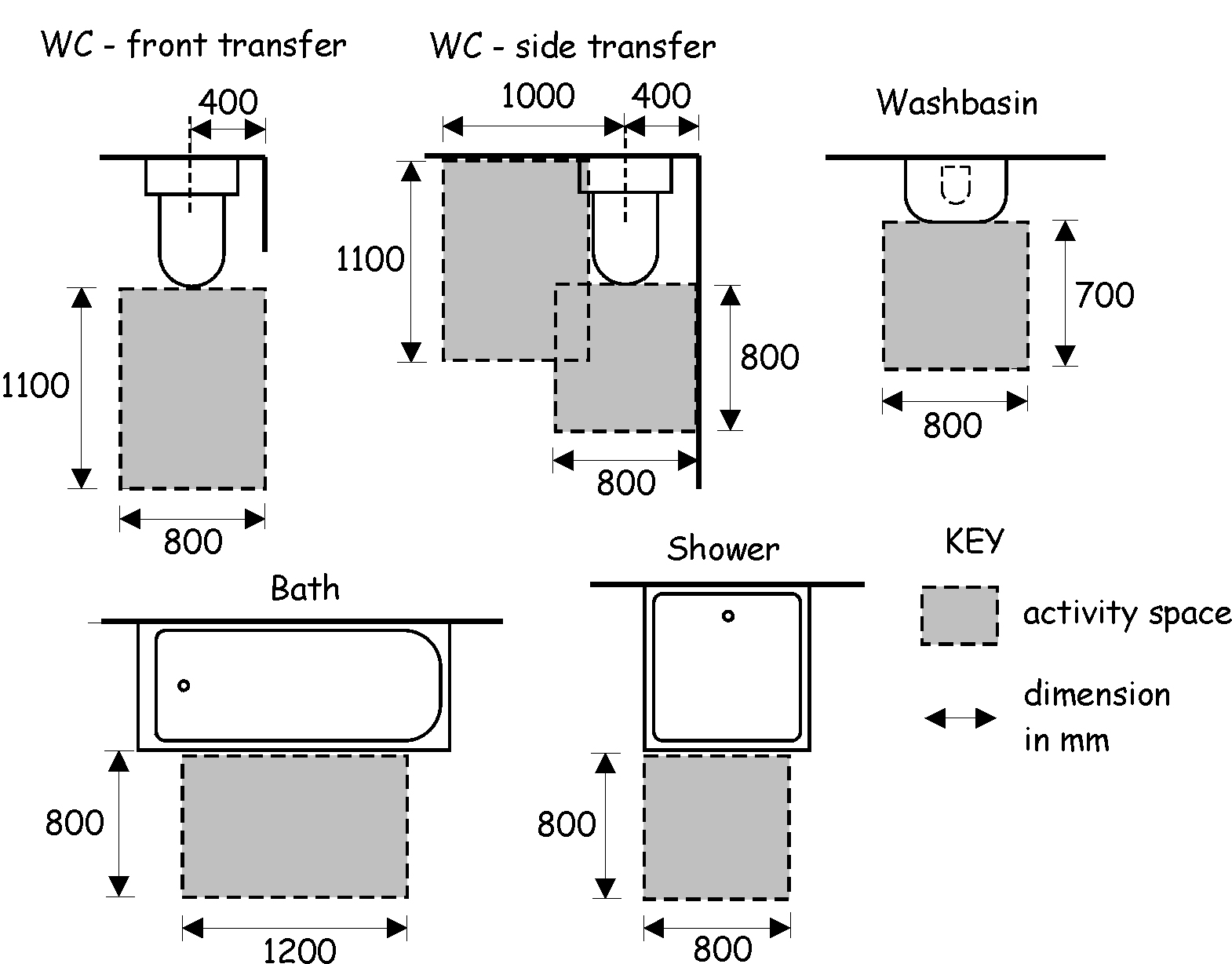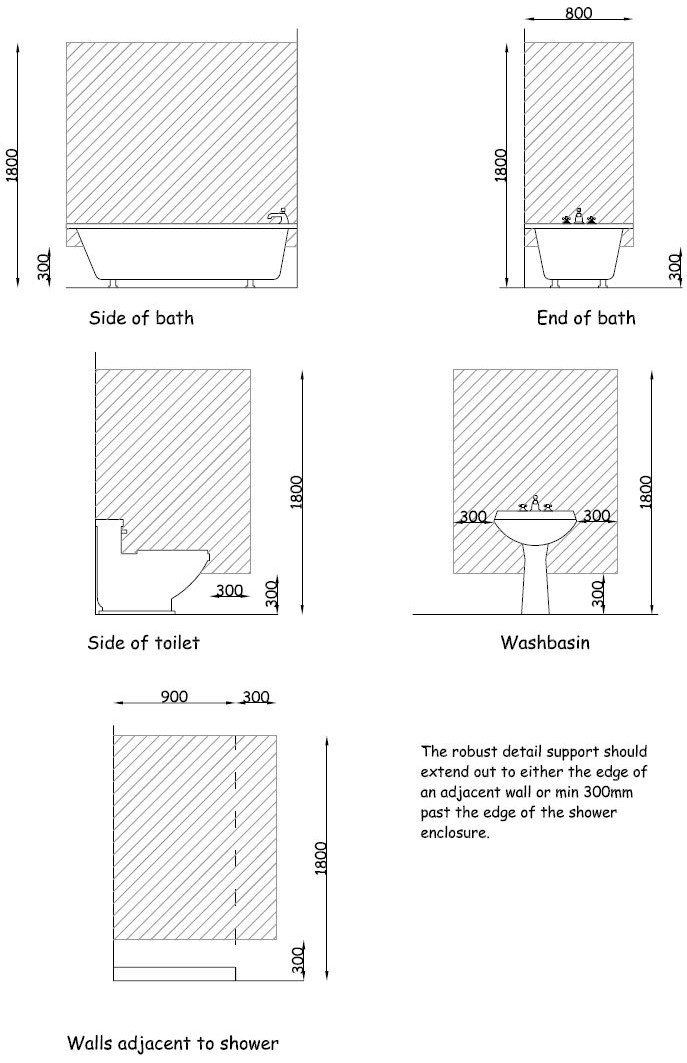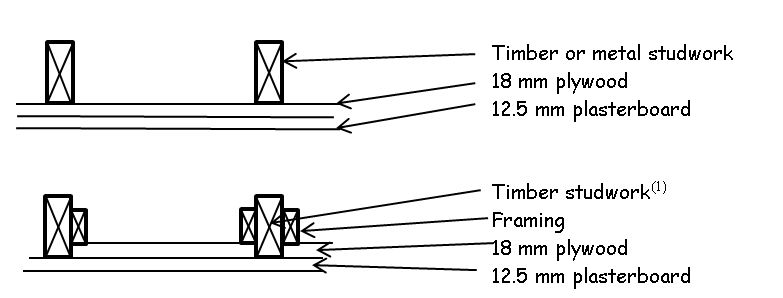3.12 Sanitary facilities
|
Sanitary accommodation that is more immediately accessible and offers both adaptability and flexibility of layout gives a more sustainable solution that will simplify modifications to the design and layout of dwellings, helping to reduce cost and disruption and better enabling people to remain in their home as their circumstances change.
Although not recommending that sanitary facilities on the principal living level of a dwelling be designed to an optimum standard for wheelchair users, it should be possible for most people to use these facilities unassisted and in privacy.
Extending standards to address ‘liveability’ and the needs of occupants supports the Scottish Government's aim of promoting a more inclusive built environment and will better address the changing needs of occupants over time. This approach to the design of dwellings ensures that Scotland's housing stock can respond to the needs of our population, now and in the future.
The guidance in this standard and Standard 3.11, together with the guidance in Section 4, Safety relating to accessibility, has been based around, and developed from, issues that are included in ‘Housing for Varying Needs’ and the Lifetime Homes concept developed by the Joseph Rowntree Foundation.
The provision, on one level, of accessible sanitary accommodation under this standard, together with an enhanced apartment, and kitchen (Standard 3.11) and improvement to circulation spaces (Standard 4.2) will assist in creating more sustainable homes.
Lead in water - the human body absorbs lead easily from drinking water and this can have a negative effect on the intellectual development of young children. Although mains water supplies do not contain significant levels of lead, recent research studies have shown that leaded solder plumbing fittings, normally used for heating systems, have been used on drinking water pipework in contravention of the Scottish Water Byelaws 2004. Further guidance can be obtained from Scotland and Northern Ireland Plumbing Employers Federation (SNIPEF) http://www.snipef.co.uk/ and Scottish Water. http://www.scottishwater.co.uk/.
Conversions - in the case of conversions, as specified in regulation 4, the building as converted shall meet the requirement of this standard (regulation 12, schedule 6).
Every dwelling should have sanitary facilities comprising at least 1 watercloset (WC), or waterless closet, together with 1 wash hand basin per WC, or waterless closet, 1 bath or shower and 1 sink. It is normal for the sink to be located in a kitchen.
To allow for basic hygiene, a wash hand basin should always be close to a WC or waterless closet, either within a toilet, or located in an adjacent space providing the sole means of access to the toilet.
There should be a door separating a space containing a WC, or waterless closet, from a room or space used for the preparation or consumption of food, such as a kitchen or dining room.
If a waterless closet is installed it should be to a safe and hygienic design such as:
National Sanitation Foundation Certification to Standard NSF 41: ‘wastewater recycling/reuse and water conservation devices', or
NFS International Standard NSF/ANSI 41-1999: ‘non-liquid saturated treatment systems’, or
to the conditions of a certification by a notified body.
Although some European countries manufacture waterless closets, they have not as yet been tested to any recognised standard. This does not mean that they are unacceptable, just that care should be taken in their choice to ensure they are both safe and hygienic in use.
Bathrooms and toilets designed to minimum space standards can often create difficulties in use. As the ability of occupants can vary significantly, sanitary accommodation should be both immediately accessible and offer potential for simple alteration in the future.
A dwelling should have at least 1 accessible WC, or waterless closet, and wash hand basin and at least 1 accessible shower or bath.
These sanitary facilities should be located on the principal living level of a dwelling and be of a size and form that allows unassisted use, in privacy, by almost any occupant. This should include use by a person with mobility impairment or who uses a wheelchair, albeit with limited manoeuvring space within the sanitary accommodation.
An additional accessible toilet may be needed on the entrance level of a dwelling where this is not also the principal living level (see clause 4.2.10).
Accessible sanitary accommodation should have:
a manoeuvring space that will allow a person to enter and close the door behind them. This should be at least 1.1m long by 800mm wide, oriented in the direction of entry, and clear of any door swing or other obstruction, and
except where reduced by projection of a wash hand basin, unobstructed access at least 800mm wide to each sanitary facility, and
an activity space for each sanitary facility, as noted in the diagram below. These may overlap with each other and with the manoeuvring space noted above. A door may open over an activity space, and
an unobstructed height above each activity space and above any bath or shower of at least 1.8m above floor level, and
walls adjacent to any sanitary facility that are of robust construction that will permit secure fixing of grab rails or other aids in the zones noted in figure 3.32 (all indicated sizes are minimum dimensions), and
where incorporating a WC, space for at least one recognised form of unassisted transfer from a wheelchair to the WC.
Additional information:
Though commonly as shown, the activity space in front of a WC need not be parallel with the axis of the WC.
Where allowing side transfer, a small wall-hung wash hand basin may project up to 300mm into the activity space in front of the WC.
The projecting rim of a wash hand basin may reduce the width of a route to another sanitary facility to not less than 700mm.
A hand-rinse basin should only be installed within a toilet and only if there is a full-size wash hand basin elsewhere in the dwelling.
An accessible bathroom should be of a size that will accommodate a 1.7m x 700mm bath (or equivalent). The activity space in front of a bath may be at any position along its length. Within an accessible bathroom, it should be possible to replace the bath with an accessible shower without adversely affecting access to other sanitary facilities.
An accessible shower room should be of a size that will accommodate either a level-access floor shower with a drained area of not less than 1.0m x 1.0m (or equivalent) or a 900mm x 900mm shower tray (or equivalent). The drained area of a level-access floor shower may overlap with activity or manoeuvring spaces where access to other sanitary facilities is not across the drained area.
Alternative - space for future shower - where a dwelling has a bathroom or shower room on another level, which is not en suite to a bedroom, some occupants may not require the immediate provision for bathing on the principal living level. Where this is the case, the principal living level may instead have a separate, enclosed space of a size that, alone or by incorporation with the accessible toilet, will permit formation of an accessible shower room (as described above) at a future date. This space can, instead, offer useful storage space.
This space should have a drainage connection, positioned to allow installation of either a floor shower or raised shower tray, sealed and terminated either immediately beneath floor level under a removable access panel or at floor level in a visible position. The structure and insulation of the floor in the area identified for a future floor shower should allow for the depth of an inset tray installation (all floors) and a ‘laid to fall’ installation (solid floors only). If not adjacent to an accessible toilet and separated by an easily demountable partition, a duct to the external air should be provided to allow for later installation of mechanical ventilation.
Examples of robust wall construction include masonry walling and suitably reinforced timber and metal stud partitioning. The following sketches indicate how timber or metal stud partitioning may be reinforced in preparation for the future installation of grab rails.
Additional information:
Refer to manufacturer's information for suitable construction details for fixing or securing plywood reinforcement to metal stud partitioning.
Where an apartment is intended for use solely as a bedroom, it is considered a private space. To ensure that privacy can be maintained, the only accessible sanitary accommodation in a dwelling should not be en suite, reached through such an apartment.
Additional sanitary facilities need not be provided as part of an extension to, or alteration of, a dwelling. However an additional accessible toilet may be needed under the circumstances set out in clause 4.2.10, if one does not exist on the entrance level of a dwelling.
If it is intended to install a new sanitary facility on the principal living level or entrance storey of a dwelling and there is not already an accessible sanitary facility of that type within the dwelling, the first new facility should be in accordance with the guidance given in clauses 3.12.3 and 3.12.4.
In the case of alterations within an existing dwelling, the new sanitary facility should be in accordance with guidance given in clause 3.12.3 as far as is reasonably practicable. This recognises that it may not always be possible, within the confines of an existing building, for accessible sanitary facility to be in accordance with guidance and that the provision of a facility that is usable by most occupants will still improve amenity.
Alteration of existing facilities - if altering existing sanitary accommodation on the principal living level or entrance storey of a dwelling which meets the guidance in clause 3.12.3 or the previous guidance for an accessible toilet (see below), any changes should at least maintain the level of compliance present before alterations.
Existing sanitary accommodation which meets the guidance in clause 3.12.3 or the previous guidance for an accessible toilet (see below) should only be removed or relocated where facilities at least equivalent to those removed will still be present within the dwelling.
Removal of existing facilities - a sanitary facility that is not an accessible facility may be altered or removed where the minimum provision for a dwelling, set out in clause 3.12.1, is maintained.
Accessibility of existing facilities - however where activity spaces for existing sanitary facilities come close to meeting either the current recommendations in clause 3.12.3 or the previous guidance for an accessible toilet, they will still offer greater amenity to a wide range of people and should be treated in the same way as accessible sanitary facilities when considering altering or relocating as noted above.
The previous guidance for an accessible toilet sought an activity space, clear of any door swing, of 800mm wide x 750mm deep in front of, but not necessarily centred on, the WC. A small wall-hung wash hand basin could project into this activity space.


